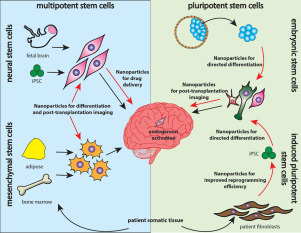当前位置:
X-MOL 学术
›
Adv. Drug Deliver. Rev.
›
论文详情
Our official English website, www.x-mol.net, welcomes your
feedback! (Note: you will need to create a separate account there.)
Nanoparticle technology and stem cell therapy team up against neurodegenerative disorders.
Advanced Drug Delivery Reviews ( IF 15.2 ) Pub Date : 2019-02-21 , DOI: 10.1016/j.addr.2019.02.007 Caroline Vissers 1 , Guo-Li Ming 2 , Hongjun Song 3
Advanced Drug Delivery Reviews ( IF 15.2 ) Pub Date : 2019-02-21 , DOI: 10.1016/j.addr.2019.02.007 Caroline Vissers 1 , Guo-Li Ming 2 , Hongjun Song 3
Affiliation

|
The convergence of nanoparticles and stem cell therapy holds great promise for the study, diagnosis, and treatment of neurodegenerative disorders. Researchers aim to harness the power of nanoparticles to regulate cellular microenvironment, improve the efficiency of cell and drug delivery to the brain, and enhance the survival of stem cell transplants. Understanding the various properties of different nanoparticles is key to applying them to clinical therapies; the many distinct types of nanoparticles offer unique capacities for medical imaging, diagnosis, and treatment of neurodegeneration disorders. In this review we introduce the biology of Alzheimer's, Parkinson's Disease, and amyotrophic lateral sclerosis, and discuss the potentials and shortcomings of metal, silica, lipid-based, polymeric, and hydrogel nanoparticles for diagnosis and treatment of neurodegenerative disorders. We then provide an overview of current strategies in stem cell therapies and how they can be combined with nanotechnology to improve clinical outcomes.
中文翻译:

纳米颗粒技术和干细胞疗法联手对抗神经退行性疾病。
纳米粒子和干细胞疗法的融合为神经退行性疾病的研究、诊断和治疗带来了巨大的希望。研究人员的目标是利用纳米粒子的力量来调节细胞微环境,提高细胞和药物输送到大脑的效率,并提高干细胞移植物的存活率。了解不同纳米粒子的各种特性是将其应用于临床治疗的关键;许多不同类型的纳米颗粒为神经退行性疾病的医学成像、诊断和治疗提供了独特的能力。在这篇综述中,我们介绍了阿尔茨海默病、帕金森病和肌萎缩侧索硬化症的生物学,并讨论了金属、二氧化硅、脂基、聚合物和水凝胶纳米颗粒在神经退行性疾病诊断和治疗中的潜力和缺点。然后,我们概述了干细胞疗法的当前策略以及如何将它们与纳米技术相结合以改善临床结果。
更新日期:2019-11-18
中文翻译:

纳米颗粒技术和干细胞疗法联手对抗神经退行性疾病。
纳米粒子和干细胞疗法的融合为神经退行性疾病的研究、诊断和治疗带来了巨大的希望。研究人员的目标是利用纳米粒子的力量来调节细胞微环境,提高细胞和药物输送到大脑的效率,并提高干细胞移植物的存活率。了解不同纳米粒子的各种特性是将其应用于临床治疗的关键;许多不同类型的纳米颗粒为神经退行性疾病的医学成像、诊断和治疗提供了独特的能力。在这篇综述中,我们介绍了阿尔茨海默病、帕金森病和肌萎缩侧索硬化症的生物学,并讨论了金属、二氧化硅、脂基、聚合物和水凝胶纳米颗粒在神经退行性疾病诊断和治疗中的潜力和缺点。然后,我们概述了干细胞疗法的当前策略以及如何将它们与纳米技术相结合以改善临床结果。











































 京公网安备 11010802027423号
京公网安备 11010802027423号